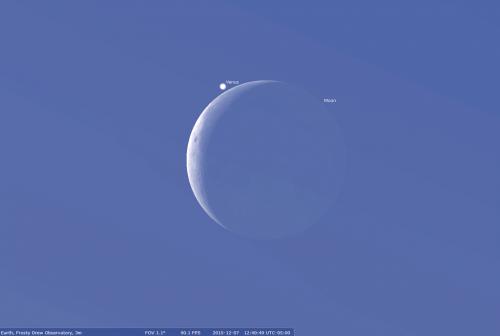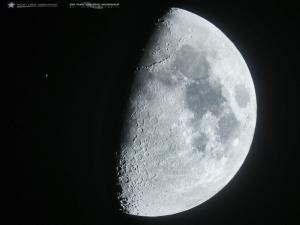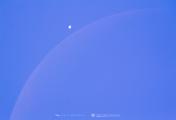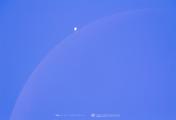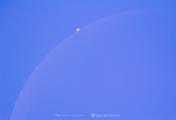The Occultation of Venus
UPDATE: (2015.12.08 09:20) Clouds thinned out and cleared just in time for a fabulous view of the occultation at Frosty Drew Observatory. See below for photos and a video of the occultation from Frosty Drew.
---------------------------------------
On Monday, December 7th a stunning daytime celestial event will occur when the Moon visibly overtakes Venus in the afternoon daytime sky. This event is called an occultation and it is the last planetary occultation of 2015.
Lunar occultations occur when the Moon passes in between our view of a planet or star. This happens because the Moon, which orbits Earth every 27.3 days, visibly moves across the sky at a slower rate than the stars. Stars appear to move 15° per hour from the East to the West due to Earth's axial rotation, this is called “sidereal time”. Though the Moon only moves 14.45° per hour across the sky from East to West. This slight difference will cause the Moon's position to change about .55° per hour from the West to the East as it relates to background stars and planets. Since the Moon is inclined 5° from the ecliptic (the path the Sun takes across the sky), the Moon can visibly pass in between Earth and planets depending on your viewing location. When this happens, we can observe the Moon overtake the planet at a rate of about .55° per hour. Since the Moon covers an area of sky about .5° in diameter, the occultation will last about an hour.
Starting at 12:45 p.m. EST on December 7th, Venus will begin to pass behind the Northwest edge of the Moon. Once fully occulted, Venus will no longer be visible to the observer. At 1:44 p.m., Venus will emerge from behind the East edge of the Moon. On the day of the occultation, the Moon will sport a 14% waning crescent phase and Venus will show off a 69% waxing gibbous phase.
Viewing the occultation will be a slight challenge for us in New England. First, the occultation is happening during the daytime hours, so the Moon and Venus will not appear as bright as they do in twilight. Secondly, the occultation will occur just before moonset, so a low westerly view will be required. At 12:45 p.m. Venus will be about 15° above the Western horizon. When Venus re-appears, it will only be about 4° above the Western horizon. Though binoculars or a telescope will make for excellent viewing, the occultation will be naked eye visible.
Occultations happen rather regularly, though they usually involve the Moon and a dim star. Being that Venus is the third brightest object in the sky (the Moon is the second brightest), this occultation is certainly an event to catch. To view the entire occultation in New England, you will need to find a spot with an excellent view of the Western horizon. Clear skies will also be required. If you snap a photo or video of the occultation, be sure to post it on our Facebook page and we will share it on our time line. So take a late lunch break and get out for the last occultation of 2015!
Photos and time lapse video of the occultation:
- Author:
- Scott MacNeill
- Entry Date:
- Dec 7, 2015
- Published Under:
- Scott MacNeill's Columns

